4 Alternatives to Underground Sprinkler Systems for Lush Lawns
Author: Chris Miller | Editor: Omar Alonso
Review & Research: Jen Worst & Chris Miller
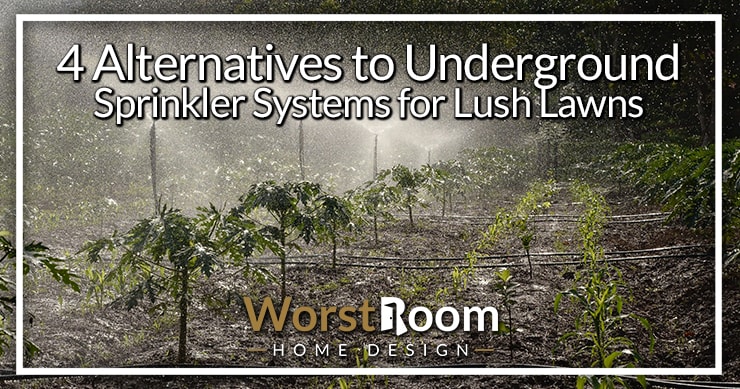
Alternatives to underground sprinkler systems are convenient and less expensive, at the trade-off of a little manual intervention. While we'd like the real deal, perhaps we can't afford the cost or the disruption to our operation.
An underground sprinkler system is an innovative and efficient way to keep your lawn watered and healthy. This is a system that works through a central controller, which can come on automatically or manually.
The controller sends a signal to the valves in the sprinkler system, which open upon command and allow water to come through the underground pipes. When there is water pressure in the pipes, the underground sprinklers pop up and irrigate the area around them.
This is a common watering technique used on sports fields and large lawns and gardens. However, it is certainly an elaborate technique that may not be the best fit for a small lawn or garden in a home.
There are several easier and less complicated ways of keeping your lawn looking green and fresh. The following are some of the methods you may want to consider as alternatives to underground sprinkler systems.
4 Alternatives to Underground Sprinkler Systems
Who really wants to tear up their yard or garden to install water pipes and buy the expensive electronics needed to make it work? Not me. These sprinkler system alternatives get the job done just as well, since we're likely talking about an area much smaller than a sports field or a farm.
Drip Irrigation
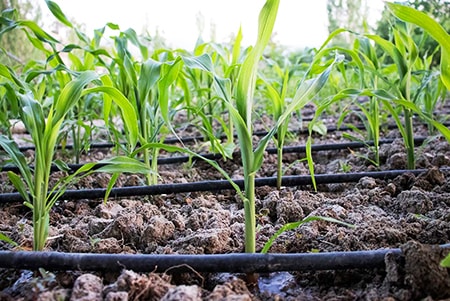
Drip irrigation is one of the best ways to keep your lawns green and lush. This is a simple method of irrigation where you pierce holes into a regular hose pipe and allow water to trickle into the soil throughout the day.
You have complete control over the stream of water. Since the hole in the hose pipe will also be small, you do not have to worry about your lawn flooding or the roots of the plants rotting with over-watering.
You can also turn on the outdoor faucet types you have for some time in the morning, and the water will trickle near the bed of the flowers or the plants you are growing. This is a simple method as you can simply leave the water on for a bit without worry.
The water will not be wasted because it will trickle out of the pipe in small quantities, enough to keep the soil moist and the plants watered. You can even build this system up in the air to cover more ground at once.
If you are tending to a garden or a vegetable patch, this is one of the best methods you can use to water them. Drip irrigation is frequently used on farms where the crop is a runner, such as strawberries. You can similarly use drip irrigation for a bed of flowers and small plants.
And since you have rows in your garden, you can leave the garden hoses between the rows and they won't be extremely visible or be an eye sore. This will save you a lot of time of having to re-set up the hoses each time you need to water your plants or grass.
Once you have got the drip irrigation method and system right, you don't need to worry about watering your lawn manually. The drip irrigation system will take care of it and your lawn will always look healthy, lush, and green.
However, this system does have some limitations if the lawn is very large. It requires a lot of labor and you need to get a lot of logistics right to be able to cover the whole lawn with the drip irrigation pipes.
But it is certainly a great alternative to an underground sprinkler system for a small lawn or yard. If you want to maintain a flower border near your boundary wall or do a plant installation, the drip irrigation method is one of the best for this.
Above-Ground Sprinklers
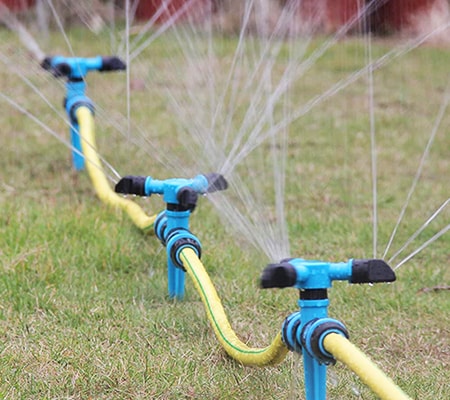
Manual, above-ground sprinklers will do the same job as an underground sprinkler, except these will be placed above the ground and use a motor that makes the sprinkler head move in circular or horizontal motions so that the entire surface area of the lawn is covered.
If you have a large lawn that requires regular watering, this is one of the best alternatives to underground sprinkler systems. You'll need to either move it around after some time to cover more ground or have two or three of these running at once if you want to save time. Luckily they're inexpensive.
Above-ground sprinklers are above the ground and are not automatic like most underground systems, but they are certainly reliable. Manual sprinklers have been the preferred choice of several gardening enthusiasts and has been one of the earlier arrivals on the market.
Since it has been around for so long, this system of irrigation has improved and become more technically sound over the years. You can try several manual sprinklers and see which one suits your needs the best.
Though the discussion so far has been about manual sprinklers, there are also sprinklers in the market which can be programmed so they come on a certain time every day and also go off after a stipulated amount of time.
These, of course, are likely to be more expensive sprinklers but they certainly get the job done and get the job done well. You've seen manual sprinklers if you've ever driven through a suburb in the spring or summer, likely with kids playing in them.
Do-It-Yourself Sprinklers
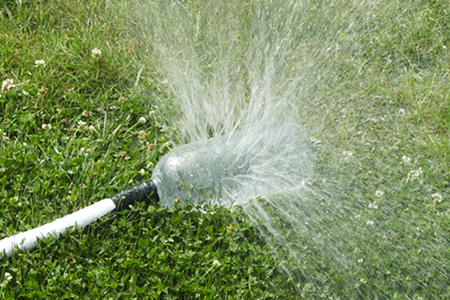
If you have some experience with engineering and doing handiwork around the house, you can also make your own DIY underground sprinkler system. It's really not that complicated either way.
This is a great option for those who have the aforementioned experience and are also shying away from installing an underground sprinkler system for fear that it will be too much of an expense (which it usually is).
If you are looking to make your own underground sprinkler system, you should get rid of all unrealistic expectations, first things first. Since you are putting it together on your own, it's likely that the system will require maintenance every now and then, and may not be as sturdy.
But if this is something you have reconciled yourself to, then it's perhaps a good idea to give this a shot. If this is for a small garden or lawn, this isn't such a big gamble as even a makeshift underground sprinkler system should do the job. A small water leak is perfectly fine in these cases, too. It's not like you'll need any of these sandbag alternatives to stop the flow.
There are several tutorials online which will take you through the things you need to acquire to put this system together, and the steps you should follow to make this DIY system come to life. Remember not to be too hard on yourself, and also be realistic about when you need to give up and call a professional.
However, if you do manage to pull this off, this can be an incredible feat that will save you a lot of money and will also keep your lawn watered and green. Take this project on if you are confident of your skills with tools. Remember, since this is an alternative underground sprinkler system, there will be some digging involved.
Manual Hose & Nozzle Watering
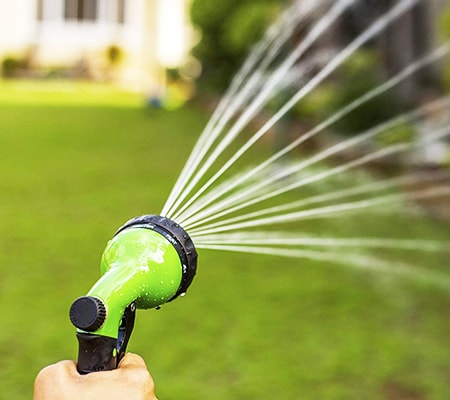
This method doesn't require too much explanation. To put it simply, you need to invest in a garden hose pipe and water the lawn yourself. This will allow you to control how much water goes into which plant and where you can hold off on putting water for a bit.
Of course, this is a time-consuming job and if you are looking for a method of irrigation that takes care of itself, this may not be the right option for you. But the customization abilities are nice, especially with the various nozzles you can purchase.
However, tending to a garden or a lawn will require intervention on your part at some point, and this will allow you to nurture your lawn and plants far better than any underground sprinkler system will. It's actually a peaceful and calm time you'll come to enjoy.
Despite the effort, you can also take this to mean that you have set aside 20 minutes of your day only for yourself, to be in your garden and to tend to plants you are growing, like if you chose the best time to plant fruit trees or are trying to save a dying tree and need to water them an exact amount.
It can be a very therapeutic part of your day and you will certainly see a lot of benefits of watering your lawn on your own—not only for your garden but even for your own peace of mind.
Gardening is one of the best ways to slow things down for a bit and take some time off for yourself. Sure, it is work but it doesn't have to feel like work if you take joy in it. You can also experiment with different gardening tools such as various types of sprinkler heads for your hose pipe so you can manage the force of the water.
Depending on the size of your garden, this activity can be completed in no time but it is certainly something you need to set time aside for. The first few times you do this, it will seem like a chore. But once you incorporate watering your garden into your daily routine, it will become something you look forward to doing.
Sprinkler System Alternatives Work Well
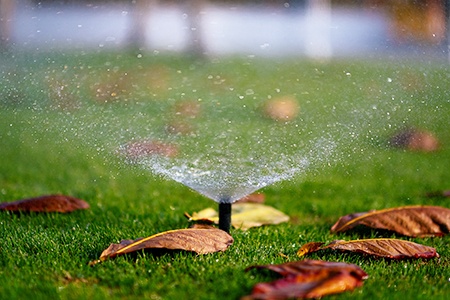
An underground sprinkler system is an elaborate and often expensive method of watering your lawns. They come with complicated problems like the sprinkler's not turning off or on at the right times or at all. The above sprinkler system alternatives are a cheaper, simpler, and enjoyable methods.
Though you can turn on the tap and let the sprinkler take care of the watering, this system does require some monitoring as if there is a burst underground, or if a pipe has come loose, you will not be able to tell unless you pay close attention.
From the options mentioned above, it is clear that there are some simple and old-school options that you can consider as an alternative.
If you think that an underground sprinkler system is the best option for you but the cost is what is keeping you from installing one in your home, there are ways to do it yourself for much cheaper, provided you have the basic expertise and skill set to see this project through.
Regardless of which method you choose, it is clear that there are viable alternatives to underground sprinkler systems and you should certainly consider them before investing your money into an expensive and extravagant irrigation system.



